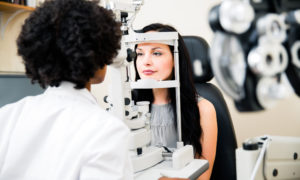April 28, 2021

Samsung Electronics is re-purposing older smartphones to expand access to ophthalmic healthcare in under-served communities around the world, according to an announcement posted to the company’s website.
Samsung partnered with the International Agency for the Prevention of Blindness (IAPB) and Yonsei University Health System (YUHS) in Korea to create medical devices1 that screen for eye disease by “upcycling” Galaxy smartphones that are no longer of use. According to Samsung, this Galaxy Upcycling program is helping to address approximately 1 billion global cases of vision impairment that are preventable with proper diagnosis.
At least 2.2 billion people have a form of vision impairment and almost half of these cases were preventable or have yet to be addressed, according to World Health Organization (WHO). There is a large disparity in the prevalence of vision impairment depending on the affordability and availability of eyecare services. This is estimated to be four times more common in low- and middle-income regions as compared to high-income regions.2
“People around the globe face barriers to accessing fundamental healthcare, and we saw an opportunity to engineer smart, innovative solutions that reuse products to drive more sustainable practices and make a positive impact in our communities,” said Sung-Koo Kim, vice-president of Sustainability Management Office, Mobile Communications Business at Samsung Electronics. “This program embodies Samsung’s belief that technology can enrich people’s lives and help us build a more equitable and sustainable future for all.”
Other Articles to Explore
Samsung says it created the Galaxy Upcycling program in 2017 to introduce innovative ways that Galaxy devices can make a positive impact. Through the program, an older Galaxy smartphone can become the brain of the EYELIKE3 handheld fundus camera, which connects to a lens attachment for enhanced fundus diagnosis, while the smartphone is used to capture images. The Galaxy device then utilizes an artificial intelligence algorithm to analyze and diagnose the images for ophthalmic diseases, and connects to an app that accurately captures patient data and suggests a treatment regimen at a fraction of the cost of commercial instruments. The diagnosis camera can screen patients for conditions that may lead to blindness, including diabetic retinopathy, glaucoma and age-related macular degeneration.
“We were looking for an eye health diagnosis solution that was cost-effective to reach as many people as possible, and when we saw the performance of Samsung’s Galaxy smartphones, we wanted to integrate their upcycling efforts into our research,” said Dr. Sangchul Yoon of Yonsei University Health System. “The combination of using multiple optical technologies and artificial intelligence, coupled with camera performance of a Galaxy smartphone, created an affordable medical device that was just as capable as a fundus camera used by medical professionals. This not only solved a health issue, but a growing environmental concern as well.”
References
1 EYELIKE is cleared by South Korea’s Ministry of Food and Drug Safety.
2 Vision Loss Expert Group of the Global Burden of Disease Study. Causes of blindness and vision impairment in 2020 and trends over 30 years: evaluating the prevalence of avoidable blindness in relation to “VISION 2020: the Right to Sight”. Lancet Global Health 2020. doi.org/10.1016/S2214-109X(20)30489-7
3 Trademark registered in Vietnam, Korea, Bangladesh and India.



























